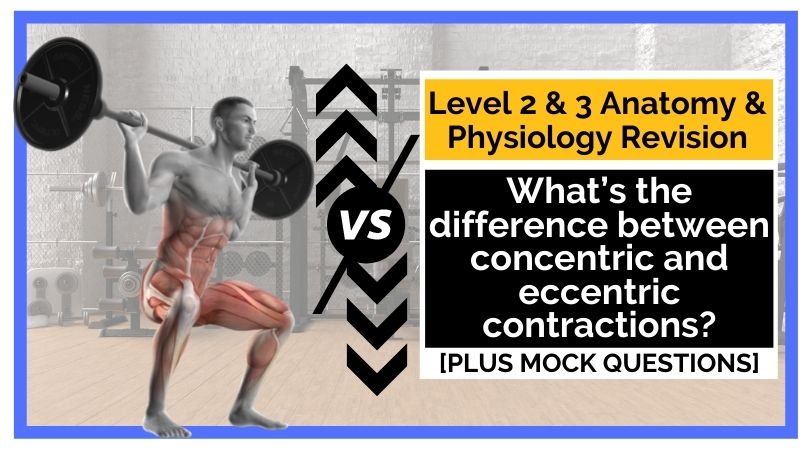As a FITPRO you need to understand Concentric and Eccentric Contractions, and how these relate to the phases of movement in each exercise.
This is part of the Level 2 and Level 3 anatomy and physiology exam and also going to help you understand movement and plan for your client’s exercise sessions effectively.
There are two uses of the term “Concentric and Eccentric” and in today’s blog and video, I’ll explain both of these and give examples of how they might appear in your exam.
Watch the video:
Two meanings one phrase
The phrase “concentric and eccentric” is used in different ways:
- It relates to the concentric and eccentric muscle contractions
- It relates to the lifting or lowering phase of a movement
Let’s look into these in more detail…
Concentric and eccentric muscle contractions
This would appear in your exam like this:
“What happens to a muscle during concentric contraction”
The question is asking about the concentric muscle contraction rather than phases of movement. To answer this question you need to know what happens during a concentric and eccentric contraction, and how these differ.
First of all, make sure you’ve learned about how a muscle contracts. You’ll need to understand the sliding filament theory and that a muscle contracts by getting shorter and longer along its length. When skeletal muscle contracts the origin and insertion of the muscle get closer together, which pulls on the tendon, and then on the bone. This then creates action at the joint.
A Concentric Muscle Contraction = When the muscle contracts and shortens
For example, if the Biceps Brachii contracts Concentrically, the muscle shortens and two attachment points go towards each other, creating flexion at the elbow.
An Eccentric Muscle Contraction = When the muscle contracts and lengthens or elongates
For example, if the Biceps Brachii contracts Eccentrically, the muscle lengthens and the two attachment points move apart from each other, creating extension at the elbow.
so in answer to the question:
“What happens to a muscle during concentric contraction”
You would expect the answer to be “the muscle shortens”
Now let’s take a look at the other use of the term “concentric and eccentric”
The lifting or lowering phase of a movement
Every movement and exercise has a lifting and a lowering phase.
For example, the squat has the lowering phase when you move from standing and lower down into tripled flexed position at the bottom of the movement.
The lifting phase is then lifting from this position, against the force of gravity, to standing again.
The Concentric Phase of a Movement = The Lifting Phase, whereby the load goes towards the Clouds against gravity (c for concentric, c for clouds). Note, the load is your own body weight in a press-up, or the dumbbell in a bicep curl, or the weight stack on a Lat Pull Down machine.
The Eccentric Phase of a Movement = The Lowering Phase, whereby the load goes towards the Earth with gravity (e for eccentric, e for earth). Note, this phase feels easier, because we are no longer pushing the load against the force of gravity, instead gravity is helping the lowering phase.
A common question in your exam would be…
“What joint action occurs at the hip during the Eccentric Phase of a squat”
so, let’s break it down…
- The eccentric phase of the squat is the lowering phase, going from standing to a tripled flexed position
- The question is asking what happens at the hip during this phase
- When we are standing our hips are extended, when we squat down, the hip flexes
- So the hip moves through flexion and extension in the saggital plane.
- Concentric phase = extension of the hip which is powered by the gluteus maximus concentrically contracting
- Eccentric phase = flexion of the hip which occurs because the gluteus maximus is eccentrically contracting
so the answer would be “Flexion at the Hip”
Before I share a few mock questions with you to practice on, here are some exam day tips:
Tips to Correctly answer concentric vs eccentric quesitons
- READ the question
Now you know there are two uses of the phrase “concentric and eccentric” you need to READ the quesiton carefully, to decipher what the question is asking you - LINK the keyword
remind yourself of the difference of phase of movement and muscle contraction. Then recall the difference between concentric and eccentric - RE-READ the question
Now you have the context, re-read the question and answer it.
Test your knowledge with today’s Concentric and Eccentric mock questions:
[NOTE: The answers are below the 3rd questions]
Q1: What happens at the spine during the Concentric phase of an Abdominal Crunch?
A. Shortens
B. Flexion
C. Extension
D. Lateral Flexion
Q2: What happens during an Eccentric Muscle Contraction?
A. The muscle shortens under tension
B. The muscle lengthens under tension
C. The muscle goes up
D. The movement stops
Q3: What happens during the Eccentric Phase of a lying Barbell Triceps Extension?
A. Extension at the shoulder
B. Flexion at the shoulder
C. Flexion at the elbow
D. Extension at the elbow
Answers to the mock questions are :
Question 1= B, Question 2 = B, Question 3 = C
If you want more mock questions like this, then you can download more Free Mock Questions: DOWNLOAD NOW
Need More Help with your Level 3 Anatomy Revision?
For Trainee FITPROS Taking Their L3 Anatomy & Physiology Exam.
Learn, Revise & Pass Your Level 3 Anatomy & Physiology Exam In Under 10-hours
(Without Having To Spend Hours Revising Or Feeling Overwhelmed)
If you want to get your revision structured, learn everything you need to know and feel confident on exam day, then click the link below:

Dedicated to More
Hayley “What’s the Difference Between Concentric and Eccentric Contractions?” Bergman
Parallel Coaching
P.S. You can also find us on the following platforms:
Instagram: Follow Now
Facebook: Like Our Page
Twitter: Tweet Us
YouTube: Subscribe Here
More Anatomy Revision Blogs: HERE

